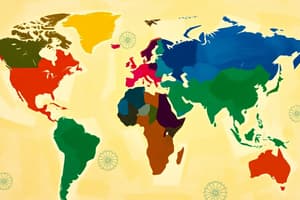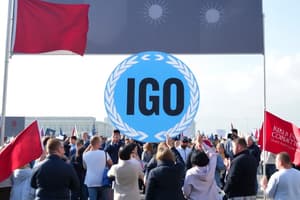Podcast
Questions and Answers
What is a key feature that distinguishes formal international government organizations (FIGOs) from informal international government organizations (IIGOs)?
What is a key feature that distinguishes formal international government organizations (FIGOs) from informal international government organizations (IIGOs)?
- FIGOs have legally binding commitments. (correct)
- FIGOs have explicit non-legal membership.
- IIGOs have a centralized oversight structure.
- IIGOs require regular meetings with secretariat support.
Which of the following is an example of an informal international government organization (IGO)?
Which of the following is an example of an informal international government organization (IGO)?
- World Trade Organization
- G-20 (correct)
- European Union
- World Health Organization
What primarily affects a state's preference for choosing informal IGOs (IIGOs) over formal IGOs (FIGOs)?
What primarily affects a state's preference for choosing informal IGOs (IIGOs) over formal IGOs (FIGOs)?
- The requirement for high policy continuity.
- A need for a legally binding enforcement mechanism.
- The desire for low negotiation costs and flexibility. (correct)
- The presence of a permanent secretariat.
In the context of IIGOs and FIGOs, which statement about 'relative power' is accurate?
In the context of IIGOs and FIGOs, which statement about 'relative power' is accurate?
Which of the following statements correctly describes the costs associated with IIGOs?
Which of the following statements correctly describes the costs associated with IIGOs?
Which characteristic is true of the structure of FIGOs compared to IIGOs?
Which characteristic is true of the structure of FIGOs compared to IIGOs?
What impact does the autonomy of states have on the choice between FIGOs and IIGOs?
What impact does the autonomy of states have on the choice between FIGOs and IIGOs?
What is a key characteristic of unanimity in the context of IGOs?
What is a key characteristic of unanimity in the context of IGOs?
How do strong states typically influence the design of international organizations (IOs)?
How do strong states typically influence the design of international organizations (IOs)?
Which of the following best explains the relationship between interdependence and IO designs?
Which of the following best explains the relationship between interdependence and IO designs?
According to Koremenos et al., what factor increases the restrictiveness of membership rules in IOs?
According to Koremenos et al., what factor increases the restrictiveness of membership rules in IOs?
What primarily determines the demand for various IGO designs according to the assumptions made by scholars?
What primarily determines the demand for various IGO designs according to the assumptions made by scholars?
What is a consequence of having more actors in an international organization as suggested by Koremenos et al.?
What is a consequence of having more actors in an international organization as suggested by Koremenos et al.?
What role do past choices play in the reform of IGOs?
What role do past choices play in the reform of IGOs?
Which form of decision-making allows a single state to prevent the passage of a proposal in an IGO?
Which form of decision-making allows a single state to prevent the passage of a proposal in an IGO?
What is one possible reason weak states might accept the terms of an IGO?
What is one possible reason weak states might accept the terms of an IGO?
What is one of the primary functions of inter-governmental organizations (IGOs)?
What is one of the primary functions of inter-governmental organizations (IGOs)?
Which aspect of IGOs indicates that they can act independently of their member states?
Which aspect of IGOs indicates that they can act independently of their member states?
What is an essential characteristic that can differentiate formal intergovernmental organizations (FIGOs) from informal intergovernmental organizations (IIGOs)?
What is an essential characteristic that can differentiate formal intergovernmental organizations (FIGOs) from informal intergovernmental organizations (IIGOs)?
What factors typically shape the design and reform of international organizations?
What factors typically shape the design and reform of international organizations?
What role do international regimes play in global governance?
What role do international regimes play in global governance?
How might a single IGO be involved in multiple international regimes?
How might a single IGO be involved in multiple international regimes?
What is a main consideration for states when choosing between IIGOs and FIGOs?
What is a main consideration for states when choosing between IIGOs and FIGOs?
Which of the following best describes the Antarctic regime?
Which of the following best describes the Antarctic regime?
What distinguishes IGOs as forums from their role as instruments?
What distinguishes IGOs as forums from their role as instruments?
Flashcards
Informal intergovernmental organizations (IIGOs)
Informal intergovernmental organizations (IIGOs)
Groups of states that cooperate through shared expectations but have no legal status or membership.
Formal intergovernmental organizations (FIGOs)
Formal intergovernmental organizations (FIGOs)
Groups of states that cooperate through formal agreements, legal membership, and a structured organization.
IGO flexibility
IGO flexibility
The ability of an IGO to adapt to new circumstances and change its rules and procedures easily.
IGO policy continuity
IGO policy continuity
Signup and view all the flashcards
Autonomy of states
Autonomy of states
Signup and view all the flashcards
Autonomy of IGO
Autonomy of IGO
Signup and view all the flashcards
IGO expertise and capacity
IGO expertise and capacity
Signup and view all the flashcards
Intergovernmental Organizations (IGOs)
Intergovernmental Organizations (IGOs)
Signup and view all the flashcards
International Regimes
International Regimes
Signup and view all the flashcards
FIGOs (Formal Intergovernmental Organizations)
FIGOs (Formal Intergovernmental Organizations)
Signup and view all the flashcards
IIGOs (Informal Intergovernmental Organizations)
IIGOs (Informal Intergovernmental Organizations)
Signup and view all the flashcards
IGOs as Forums
IGOs as Forums
Signup and view all the flashcards
IGOs as Instruments
IGOs as Instruments
Signup and view all the flashcards
IGOs as Actors
IGOs as Actors
Signup and view all the flashcards
IGOs in Multiple Regimes
IGOs in Multiple Regimes
Signup and view all the flashcards
IGO-Regime Link
IGO-Regime Link
Signup and view all the flashcards
Consensus
Consensus
Signup and view all the flashcards
Majority Rule
Majority Rule
Signup and view all the flashcards
Supermajority
Supermajority
Signup and view all the flashcards
Weighted Majority
Weighted Majority
Signup and view all the flashcards
Power in IO Design
Power in IO Design
Signup and view all the flashcards
Shared Interests in IO Design
Shared Interests in IO Design
Signup and view all the flashcards
Rational Design of IOs
Rational Design of IOs
Signup and view all the flashcards
Demand for IO Designs
Demand for IO Designs
Signup and view all the flashcards
Normative Aims in IO Design
Normative Aims in IO Design
Signup and view all the flashcards
Study Notes
Analysing International Relations - The Design of International Organizations
- Intergovernmental organizations (IGOs) are international organizations whose members are states. They manage global governance by overseeing issues like trade and the environment.
- IGOs differ in terms of membership, functions, formality, and decision-making procedures.
- International regimes are sets of rules, decision-making procedures, and organizations that govern behavior in a region or issue area. They often involve a formal treaty and/or a formal IGO.
- IGOs can act as forums for states to meet and negotiate, as instruments for states to achieve their interests, or as actors with their own interests, preferences, and ability to act.
- Examples of international regimes include the Antarctic regime and the Ozone regime.
- A single IGO can be active in multiple regimes, and a single regime may include multiple IGOs. For example, the UN is active in several regimes, and many IGOs are involved in the nuclear non-proliferation regime.
Different Forms of IGOs
- IGOs differ in various ways, including membership, function, formality, and decision-making.
- Membership can be limited (e.g., European Union, OPEC) or universal (e.g., United Nations).
- Functions can be to govern an issue area (e.g., WTO for trade), a geographic area (e.g., African Union), or promote a particular culture or set of values (e.g., Organization of Islamic Cooperation).
- Formality varies, with some IGOs being formal with written principles and members, and some informal with shared expectations.
Decision-Making in IGOs
- Decision-making can be supranational (made by an independent body) or intergovernmental (made collectively by member states).
- Intergovernmental decision-making processes can include consensus (unanimity or consensus-minus-one), majority, or supermajority votes, and some mixed approaches.
Factors Shaping IGO Design
- Power: Strong states design and promote IGOs to maximize their self-interests, whereas weak states accept them if rejection is costly. New great powers create and impose new IGOs.
- Shared interests: Interdependence exposes states to external risks, and international institutions help states manage this through mutually beneficial agreements.
- Shared normative aims: The shared normative aims of states that create them influence IGO design. Post-WWII, this involved social welfare, while post-Cold War aims included maximizing economic growth.
- Past choices: Past decisions on IGO design influence current options and decision-making. This includes situations where a minority of members block changes.
Informal IGOs
- Felicity Vabulas and Duncan Snidal (2013) detail types of IGOs without strict delegation or legal frameworks but sharing expectations.
- Examples of informal IGOs, like the Proliferation Security Initiative, highlight their flexibility and adaptability.
Differences between Formal and Informal IGOs
- Formal IGOs tend to have low flexibility but legally binding rules and commitment.
- Formal IGOs usually have high policy continuity and central oversight.
- Informal IGOs have high flexibility, non-binding rules, but uncertain policy continuity and decentralized oversight.
What Determines IGO Type Preference
- Functional efficiency: States often favor informal IGOs for their lower negotiation costs and speed, but formal IGOs are preferred when rules and enforcement are needed.
- Relative power: Status quo states generally prefer formal IGOs to lock in their power and policy preferences. Rising states often favour informal IGOs to avoid committing to stronger, longer-term rules.
IGO Autonomy
- The next topic of discussion examines how independent IGOs are from the interests of member states.
Studying That Suits You
Use AI to generate personalized quizzes and flashcards to suit your learning preferences.
Related Documents
Description
Explore the design and function of intergovernmental organizations (IGOs) and international regimes in global governance. Understand their roles in managing trade, environment, and diplomacy. Learn how these entities influence decision-making and international cooperation.




